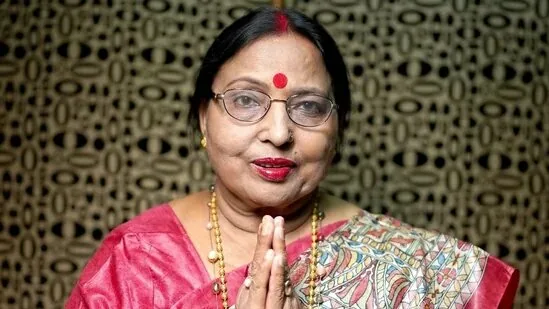
Indian folk music has lost a beloved icon with the passing of Sharda Sinha, widely celebrated for her soulful Bhojpuri, Maithili, and Magahi songs. Known as the “Nightingale of Bihar,” Sinha’s music brought the traditional folk sounds of Bihar to a global audience, leaving an indelible mark on Indian culture. Having battled multiple myeloma since 2018, Sinha was recently admitted to AIIMS, where her health declined, leading to her being placed on a ventilator. Following her death, leaders like Prime Minister Narendra Modi and Defence Minister Rajnath Singh expressed their sorrow, recognizing her invaluable contributions to folk music. Modi highlighted the enduring popularity of her songs, especially those associated with Chhath, while Rajnath Singh praised her ability to connect with audiences through her music.
Born in Samastipur, Bihar, on October 1, 1952, Sinha’s passion for folk music was deeply rooted in the regional culture of her upbringing. She pursued her love for music academically, eventually becoming a renowned teacher and performer. Her career blossomed through emotive renditions of folk classics like “Kahe Toh Se Sajna” and “Paniya Ke Jahaj Se Paltaniya Ban Ahiya Ho Rama,” which resonated widely and helped establish her as a cultural icon. Her unique style not only celebrated Bihar’s rich folk traditions but also introduced the vibrancy of Bhojpuri and Maithili music to audiences beyond India.
Sinha’s songs, especially those dedicated to Chhath Puja, became symbolic of the festival’s spirit. Her Chhath tracks, such as “Hey Chhathi Maiya” and “Ho Dina Nath,” captured the devotion and essence of the festival, making her music synonymous with its celebration. Recognized for her work in preserving Indian folk music, she received honors like the Padma Bhushan in 2018 and the Padma Shri in 1991. Sinha’s deep commitment to her roots was evident in her performances, often in traditional attire, reflecting her pride in her heritage. Her legacy, rooted in the warmth and spirit of Bihar’s folk culture, will continue to inspire and connect future generations to their cultural heritage.

Post Your Comments